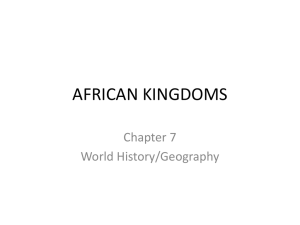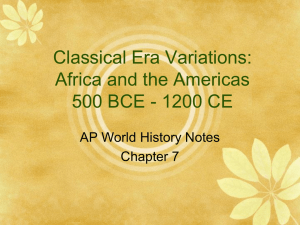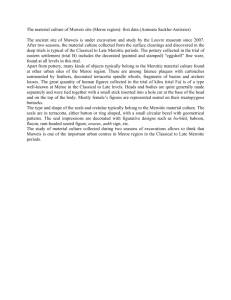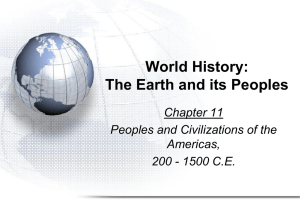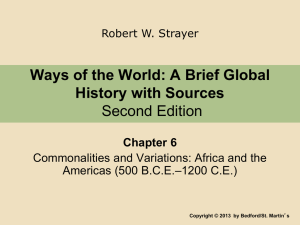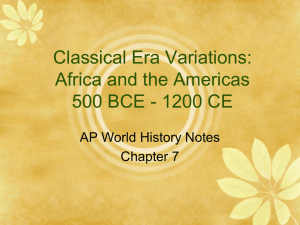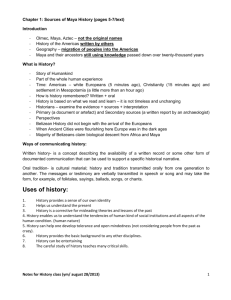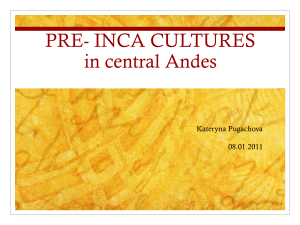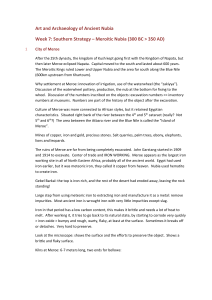Ch6 RG Key - Moore Public Schools
advertisement
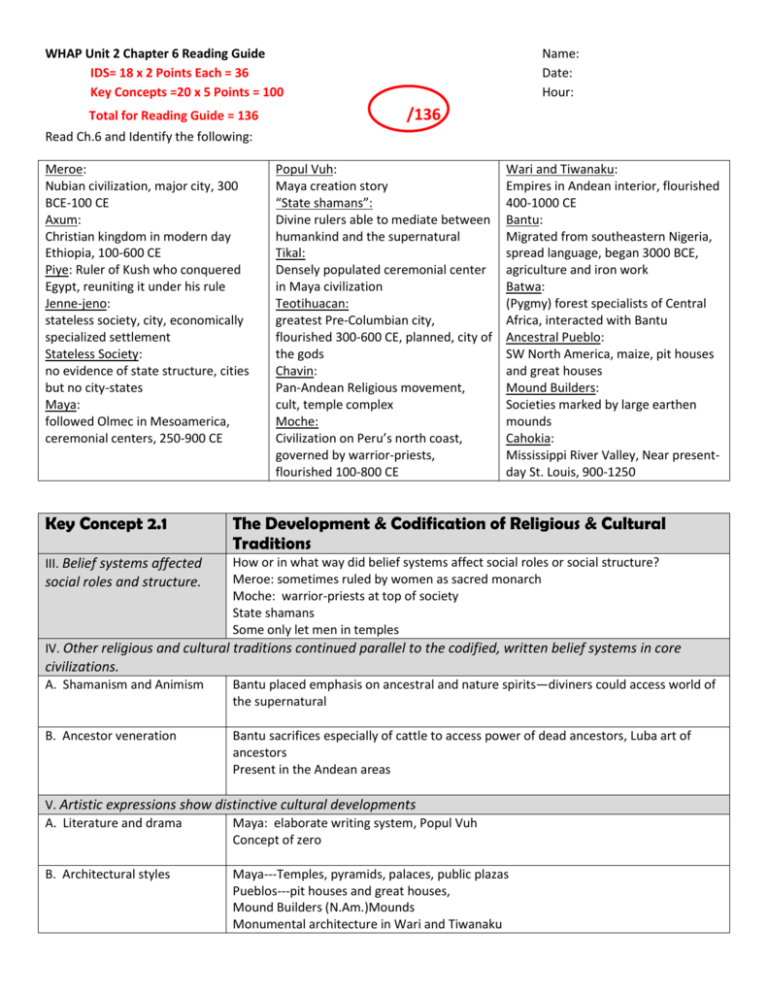
WHAP Unit 2 Chapter 6 Reading Guide IDS= 18 x 2 Points Each = 36 Key Concepts =20 x 5 Points = 100 Total for Reading Guide = 136 Name: Date: Hour: /136 Read Ch.6 and Identify the following: Meroe: Nubian civilization, major city, 300 BCE-100 CE Axum: Christian kingdom in modern day Ethiopia, 100-600 CE Piye: Ruler of Kush who conquered Egypt, reuniting it under his rule Jenne-jeno: stateless society, city, economically specialized settlement Stateless Society: no evidence of state structure, cities but no city-states Maya: followed Olmec in Mesoamerica, ceremonial centers, 250-900 CE Popul Vuh: Maya creation story “State shamans”: Divine rulers able to mediate between humankind and the supernatural Tikal: Densely populated ceremonial center in Maya civilization Teotihuacan: greatest Pre-Columbian city, flourished 300-600 CE, planned, city of the gods Chavin: Pan-Andean Religious movement, cult, temple complex Moche: Civilization on Peru’s north coast, governed by warrior-priests, flourished 100-800 CE Wari and Tiwanaku: Empires in Andean interior, flourished 400-1000 CE Bantu: Migrated from southeastern Nigeria, spread language, began 3000 BCE, agriculture and iron work Batwa: (Pygmy) forest specialists of Central Africa, interacted with Bantu Ancestral Pueblo: SW North America, maize, pit houses and great houses Mound Builders: Societies marked by large earthen mounds Cahokia: Mississippi River Valley, Near presentday St. Louis, 900-1250 Key Concept 2.1 The Development & Codification of Religious & Cultural Traditions III. Belief systems affected How or in what way did belief systems affect social roles or social structure? Meroe: sometimes ruled by women as sacred monarch Moche: warrior-priests at top of society State shamans Some only let men in temples social roles and structure. IV. Other religious and cultural traditions continued parallel to the codified, written belief systems in core civilizations. A. Shamanism and Animism Bantu placed emphasis on ancestral and nature spirits—diviners could access world of the supernatural B. Ancestor veneration Bantu sacrifices especially of cattle to access power of dead ancestors, Luba art of ancestors Present in the Andean areas V. Artistic expressions show distinctive cultural developments A. Literature and drama Maya: elaborate writing system, Popul Vuh Concept of zero B. Architectural styles Maya---Temples, pyramids, palaces, public plazas Pueblos---pit houses and great houses, Mound Builders (N.Am.)Mounds Monumental architecture in Wari and Tiwanaku C. Sculpture Axum obelisks Axum obelisks Terracotta Statues in Jenne-jeno Teotihuacan murals Meroe: statues of queens Luba statues represent female ancestors Key Concept 2.2 Development of States and Empires I. Key states and empires What are they and where are they located? Meroe, Axum in Africa Maya in Mesoamerica Chavin and Moche (coastal) in Andes, Wari and Tiwanaku in interior Andes (*Also stateless societies along Niger River are not states or empires) II. New techniques of imperial administration A. Rulers created In what ways did they set up their administrations? How were they organized? administrative institutions in Meroe=ruled by all-powerful sacred monarch many regions Axum=loose control, mostly tribute, trade, Christianity, expansion Maya=not unified empire, frequent warfare, State shamans Moche=warrior-priests, elaborate rituals/religion and government tied Wari cities had common plan and highways suggest tighter political control B. Imperial governments projected military power over larger areas using a variety of techniques Examples of techniques: Mayans had frequent warfare with capture and sacrifice of prisoners Moche had warrior-priests War elephants C. Much of the success of the empires rested on their promotion of trade and economic integration of building and maintaining roads and issuing currencies Examples of this: Meroe=major long distance trade was source of wealth and military power, camel caravans Axum=Red Sea and Indian Ocean trade, commerce taxes were great source of revenue, standardized coin Maya=swamp drainage, terracing, water management system Wari and Tiwanaku=linked by caravan trade, highways linked cities Jenne-jeno=promoted trade III. Unique social and economic dimensions developed in imperial societies in Afro-Eurasia and the Americas A. Cities Pueblo=Chako Teotihuacan Tikal Jenne-jeno Axum: monumental building Meroe Alexandria B. Social Structures Maya: had elite and artisan classes Moche: warrior-priests at the top of society Cahokia: stratified class system Natchez: clear social elite, upper-class people were required to marry commoners In Mesoamerica: luxury goods showed status (jade, turtle shells, obsidian) State shamans C. Imperial societies relied on Meroe: paid tribute to rulers a range of methods to Axum: plow-based agriculture maintain the production of Maya: large-scale human interaction, drainage system, water management, terracing food and provide rewards for the loyalty of elites. D. Patriarchy Some things opposite to patriarchy: Bantu communities less patriarchal than urban civilizations Meroe had female leaders Gender parallelism Key Concept 2.3 Emergence of Transregional Networks of Communication and Exchange I. Land and water routes became the basis for these networks A. Trade Routes Names and locations: Nubian trade with Egypt Meroe: trade with Mediterranean, and east to west with camel caravan, Axum: Red Sea and Indian Ocean trade Caravan trade linked interior Andes and coastal areas Pueblo: local trading networks, some long-distance exchange Mound Builders: extensive trade to north and south p.266 II. New technologies facilitated long-distance communication and exchange A. New technologies for Camel caravan domesticated pack animals Llamas in Andes B. Innovations in maritime technologies and knowledge Traded on rivers, seas and Indian Ocean Canoe III. More than just goods was exchanged on these networks A. The spread of crops Meroe: rainfall not irrigation! encouraged changes in Axum: plow-based farming farming and irrigation Maya: swamp drainage, terracing, water management system techniques. Moche: complex irrigation system Wari and Tiwanaku: terraced agriculture and raised field systems B. Spread of disease and effects on empires Bantu migration brought new diseases to people with little immunity Africa’s tropical climate allows more disease-carrying insects and parasites C. Religious and cultural traditions were transformed. Christianity spread to Axum, Chavin cult spread on trade routes in Andes Fall: Meroe---deforestation, conquest by Axum, later Islam Maya---drought Moche---ecological disruption in sixth century
